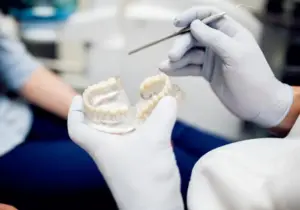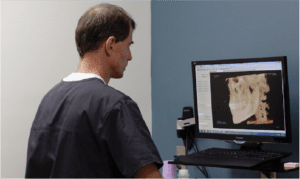Nobody wants to lose a tooth. But if you don’t replace the tooth through a dental implant, or even a less costly dental procedure like a bridge or dentures, your jawbone will deteriorate because it’s literally trying to reabsorb the area where the missing tooth was. This can make it difficult for your jawbone to accept a dental implant in the future. Because while holistic tooth replacement is the gold standard of tooth replacement, it requires healthy bone in order to perform correctly and last for decades.
We always encourage dental implant surgery immediately following a tooth extraction – because it’s the best way to preserve the jawbone. But sometimes it’s impossible to get immediate tooth replacement, either because of a facial trauma surgery that requires time to heal, or because you may not have been able to afford it in the past. Thankfully, we offer solutions to both of those problems. (Take a look at our process for making dental implants affordable here.)
If you do suffer from bone disintegration, there is something we can do to strengthen the jawbone so it can accept a dental implant. Dental bone grafting is an oral surgical process of creating a graft at the site of the deterioration that spurs the body to create new, healthy bone tissue where it is needed most. The process isn’t as painful as it sounds. In fact, it’s a relatively minor procedure; you shouldn’t feel a thing during the surgery. But one thing to consider about dental bone grafting is that there is typically a delay between the tooth extraction and grafting process, to the time you can get tooth replacement via dental implant surgery. This is because we need to give your jawbone time to regenerate its structure and strength.
Why You May Need Dental Bone Grafting Before Getting Dental Implants
Most people need dental bone grafting because their jawbones are not strong enough to accept a dental implant. But some patients may also need it to strengthen their jawbone after suffering from periodontal disease. Teeth that are misaligned can also lead to bone loss. You may need a dental bone graft to support your jawbone for misaligned teeth. This will ensure there’s enough jawbone support once your teeth are back in alignment.
Do You Need a Dental Bone Graft?
Have you lost an adult tooth? Have you suffered severely from gum disease? If so, chances are you’re a good candidate for a dental bone graft. Your dentist may refer you to a maxillofacial surgeon to do the procedure. We perform dental bone grafting with the latest technology, like PRF and dentin grafting, which use your own body’s materials and abilities to regenerate healthy bone.
Types of Dental Bone Grafts
There are many different types of dental bone grafts. Which one is right for you depends on your unique medical situation:
Sinus Lift
This type of dental bone graft is for people who have lost some of the molars on the upper row of teeth. The structures of your sinuses may start to reach downward into the gap from the missing teeth. We do a sinus lift to put them back where they belong, and then we repair the gap with dental bone grafting.
Socket Graft
You get a socket graft at the same time you have a tooth extracted. This will help prevent the bone loss following a tooth extraction. The procedure prevents your body from reabsorbing the bone near where the tooth was. This way, your jawbone will support a dental implant if you and your oral surgeon have decided that that’s the best option for tooth replacement.
Block Bone Graft
This is where a maxillofacial surgeon takes bones from the back of your jawbone, close to your wisdom teeth in order to create the graft. We usually do this for serious cases of bone loss that need extra support.
How Does Dental Bone Grafting Work?
We usually use bone from your own body. This commonly comes from the back of the jawbone or elsewhere on your body. But sometimes we get bone from human donors or use compatible animal bone, which is usually bovine.
First, we’ll give you anesthesia to the affected area. Next, we’ll clean the area. Then we make an incision in the gum line and separate it from the bone where we are going to graft new bone. We’ll place new bone between the bone areas that will then grow together. We secure the bone graft with an adhesive material that will eventually dissolve. Then we sew the incision up so it can heal.
Recovery from a Dental Bone Graft
Once the dental bone graft is complete, we’ll wrap the area in gauze. We’ll give you instructions on how to change the dressing. We’ll also prescribe you antibiotics to ward off infection. It’s important that you continue to take all of the antibiotics as prescribed to avoid the possibility of infection. We’ll also prescribe you extra strength pain relievers, because recovery can be a little difficult at first – the mouth is a sensitive and heavily used area.
You’ll need to eat a special diet of soft foods, soups, and yogurt to avoid stressing the affected area. Avoid eating anything hard like nuts or hard candy. Treat any swelling with an ice pack or package of frozen veggies. Sleep with your head elevated. This way, blood won’t gather at the dental implant and cause swelling. Staying hydrated and swishing with salt water occasionally can also protect the site of the dental bone graft from becoming infected.
Sometimes, there are unavoidable complications during recovery. If you have extreme pain that isn’t helped with painkillers, nausea, vomiting or excessive bleeding, call your oral surgeon right away so they can nip the problem in the bud. We are skilled and highly experienced at dental bone grafting – we’ve seen it all. So no matter your issue, we know how to help.









